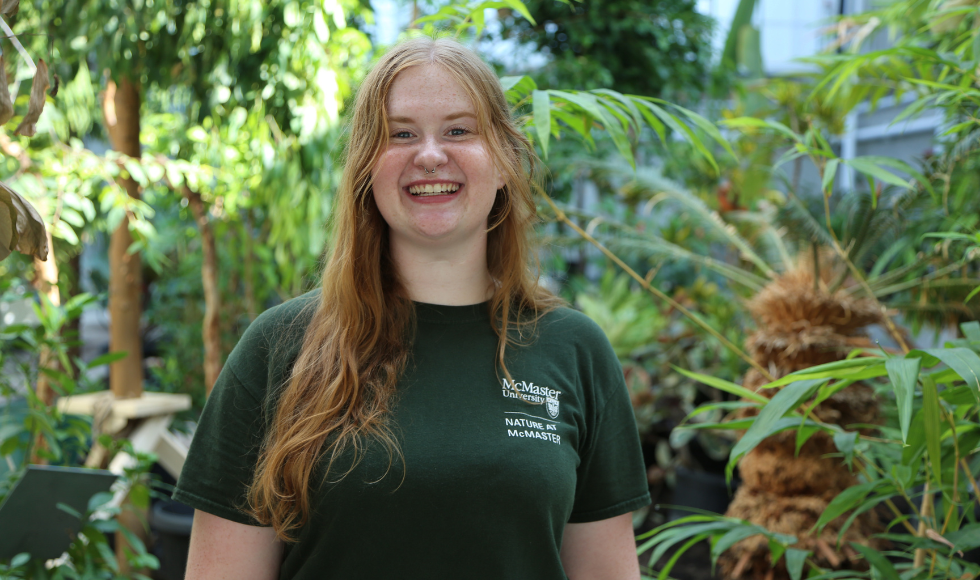‘I can’t wait for everyone to see the greenhouse bursting with life’

Calloused hands, green thumbs: After helping haul 61,000 kg of compost to the new McMaster Learning and Discovery Greenhouse, Biology undergrad and Nature at McMaster intern Renee Twyford has become a regular volunteer. And this fall, she'll be back in the state-of-the-art living lab to study plant health and work on her honours thesis.
Renee Twyford has spent her summer saving birds, surveying snakes, battling buckthorn and moving a mountain of mulch.
It’s been everything the biology undergrad had hoped for when she scored a paid internship with Nature at McMaster. The experience at Mac tops her stint as a horticultural intern at the Cincinnati Zoo in her home state of Ohio.
“I get to combine science with hands-on outdoor work – it doesn’t get better than that.”
Even the dirtiest and most demanding job’s been a joy for Twyford. All of the interns, along with a crew of volunteers and faculty members — plus a spouse — hauled 80 cubic yards of bark compost into the new Learning and Discovery Greenhouse.
That’s just over 61,000 kg, or roughly the weight of 10 African elephants.
It took the compost brigade just shy of two weeks, making around 800 trips with fully loaded wheelbarrows down a ramp and through a circuitous route to the new greenhouse’s garden beds.
Join the Greenhouse Plant Parade!
Students, faculty, staff, alumni and community members are all invited to help carry potted plants on Wednesday, Aug. 14, from our 65-year-old greenhouse to the brand-new McMaster Learning and Discovery Greenhouse, which will soon be open to the public.
Click here to learn more or sign up
Twyford came away with a few blisters, but had a blast.
“I can’t wait for everyone to see the greenhouse bursting with life. It’s going to be such an amazing place to geek out over plants and see things that can’t be found anywhere else in Hamilton.”
There’s even a reminder of home — the Dutchman’s Pipe, with its heart-shaped leaves, is native to Ohio.
Twyford continues to lend a calloused hand at the greenhouse. She comes in on weekends, volunteering alongside biology professor Susan Dudley to water and fertilize the hundreds of trees and plants that made the first cross-campus move from the old greenhouse (between the Phoenix and Hamilton Hall).

Dudley is grateful for the help and not surprised Twyford is such an enthusiastic and dedicated volunteer: Twyford was a stand-out student and “absolute pleasure” in Dudley’s experiential field course.
“Renee thrives on learning by doing,” Dudley says.
“She happily identified plants in September and was the first to pull on waders and head down muddy creek banks in December to net invertebrates.”
That was also the course in which Twyford met Wayne Terryberry — McMaster’s coordinator of outdoor recreation and natural lands — at his goat farm, and where she learned about summer internships with Nature at McMaster.
Besides pitching in at the greenhouse, Twyford and the Nature at McMaster interns have scouted every building on campus to recommend which windows need to be covered in feather-friendly dots to help reduce bird strikes.
They’ve worked with Ontario Nature to conduct snake surveys in the McMaster Forest Nature Preserve just west of the campus — it’s home to a whole lot of snakes.
In another collaboration — this time with the Adopt-A-Park program — the interns are restoring newly acquired greenspace behind Mayfair Cresent by cutting and digging out invasive species like buckthorn, garlic mustard and multifora rose.
And they’re maintaining the McMaster Forest trails, along with the McMaster Carbon Sink Forest and the five vernal ponds that have just been added to the West Campus.
Twyford will remain a greenhouse regular after her Nature at McMaster summer internship wraps up.
Along with volunteering, she’ll be working in one of the greenhouse labs on her final year thesis project.
Under the supervision of biology professor Robin Cameron, Twyford will studying how plants react and respond to disease, something made possible by the move to the new greenhouse. The lack of controlled conditions in the old greenhouse made plant science research next to impossible.
“The technology in the new greenhouse to support research is amazing.”
She also predicts record-setting community outreach — the old greenhouse drew more than 3,000 visitors annually, and now there’s far more space to see the plants from different angles and vantage points.
“Telling someone about plants is one thing. Letting them see, smell, touch or even eat some of the plants gets people really excited about botany and our natural world.”
“The opportunities for research, getting involved in the community and sharing a love and passion for plants and the environment have been endless at McMaster.”
Twyford, who switched to the honours biology research specialization after her first year, got here five years ago with dreams of some day owning a sustainable, self-sufficient farm.
She’s tweaked her plans a bit, with a new goal of becoming a rural Batman: “Plant scientist and researcher by day, farmer by night.”

